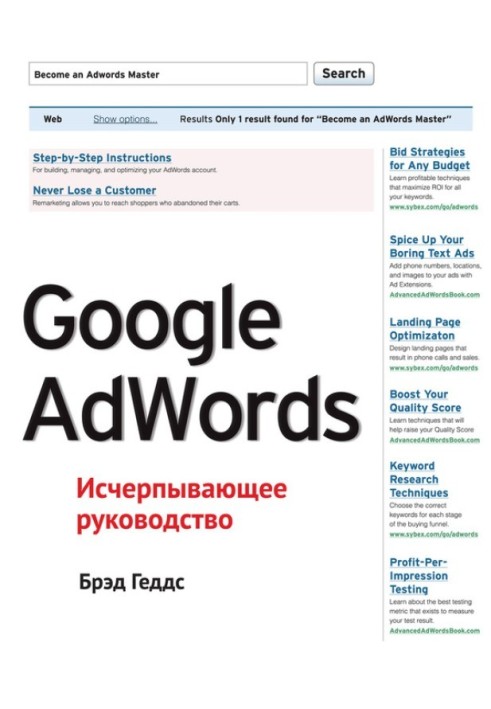Google AdWords. Comprehensive Guide
 Instant download
Instant download
after payment (24/7)
 Wide range of formats
Wide range of formats
(for all gadgets)
 Full book
Full book
(including for Apple and Android)
This book gives you the opportunity to gain first-hand knowledge from one of the world's leading experts in the field of contextual advertising, Google AdWords. The book covers the subject matter thoroughly, from basic concepts such as keywords to advanced ones such as Quality Score, remarketing, and landing page optimization. An in-depth course on Google AdWords is aimed at Internet marketers, advertising agencies, and online entrepreneurs who has a good understanding of the principles of operation of the AdWords service, but wants to get the most out of it. Published in Russian for the first time.
The process at first glance is simple: the user goes to the search engine, enters a query and gets the results. However, every step is accompanied by thoughts and expectations. Knowing how your keywords and advertisements are consistent with the search process, you can attract more visitors to your site and achieve more conversions. PPC (pay-per-click) advertising is effective because it mirrors the search process and because this goes harmoniously with it. Once you learn where PPC advertising originated and how it has evolved, you will understand what the future may hold, allowing you to continue to take advantage of this popular method.
Keywords are the foundation of a successful AdWords campaign. If you have a keyword that matches a user's query, they will be able to see your ad in search results. If you don't have a keyword that matches a user's query, they will not see your ad in search results. results page. The logic is simple: if you don't use a specific keyword, people searching for it won't see your ad. Keywords play a major role in AdWords campaigns, which is why PPC advertising is often called "keyword advertising." Keywords are not equal. Some will give a high volume of search traffic[10], others - insignificant. Some provide high conversion rates, while others generate low-quality traffic. Choosing the right keywords is the first step in advertising using Google AdWords.
It is extremely important for advertisers to understand which stage of the sales funnel keywords correspond to. If you choose them wisely and then measure the results, your chances of success will increase. If you start with general keyword research topics, and then work through them in depth, looking for keywords of a narrow topic, you will most efficiently spend the time allotted for keyword research. Where else should you turn after you've scoured your own site, competitors' sites, search results, and everything else your site's internal search tool has to offer for keywords? Where can I find hints? There are a number of online tools that can give you fresh keyword ideas.
The ad is the only element of your AdWords account that is directed to the consumer. It should attract his attention, jump forward, jump, wave a handkerchief invitingly and shout: “I, I will answer your question!” At the same time, writing advertising texts is very difficult. The message, the offer of benefits, editorial requirements and content should be closely related and squeezed into a limited number of characters. Writing advertising texts that meet all these requirements is sometimes a very difficult task.
Where should you direct the user when he clicks on your ad? The home page is not the best option in most cases. There are others, and if you choose the right landing page, the visitor will not only view your site, but will also become seriously interested in its content. It is believed that the first impression is the strongest, and this truth is as true in relation to websites as in relation to to people. If your site is trustworthy and easy to use, your first impression will be positive.
We'll assume you've done the hardest part of using AdWords: selected keywords and created relevant advertisements. Your advertising campaigns have begun to produce results. Based on their analysis, you can optimize the performance of your account using two techniques. The first allows you to increase traffic to your site. In this chapter, you'll learn how to get more impressions and clicks on your ads. And then, when the number of visitors increases, you can implement the techniques described below, which increase the number of pages viewed by visitors. The second technique helps to increase the conversion rate. You'll learn ways to improve this metric and explore additional types of conversions to attract and move as many visitors through the sales funnel as possible.
Quality Score is the most important parameter of your AdWords account, since it plays a decisive role in the success of advertising. It can decide the fate of your account. If the quality score is low, the account is doomed to fail. But a high quality score can provide a competitive advantage, and at the same time you will pay less per click. However, it is the most difficult to calculate, let alone increase across an entire account. In this chapter, we will find out which components of an account are affected by Quality Score and how, and what factors determine its value. You'll learn how to improve your Quality Score to gain a strategic advantage over your competitors.
Mobile devices have been growing in popularity over the past few years. This has become a major challenge for all web developers. There are technologies that can be used to reach and engage mobile audiences. Google AdWords supports multiple ad types with new ways to reach desktop users. You can use multimedia (video, interactive or graphical elements) to enhance the impact of your advertising campaign and increase the number of clicks to your site and the recall of your brand. Developing image or video ads can sometimes be time-consuming and expensive. In this chapter, we'll explore Google's tool for creating rich media ads within the AdWords interface, saving advertisers time and money. The chapter focuses on creating non-text ads, and in the next two we'll discuss where and how to use them in AdWords campaigns. designed for the contextual media network.
The contextual media network (CDN) is an element of Google AdWords, the essence of which is often misunderstood by advertisers. It allows you to display ads on non-search pages, such as periodicals with news articles. Viewing search pages makes up a tiny fraction of the total number of views on the network, and using display networks to display ads will significantly expand advertising coverage. However, displaying advertisements on the display network follows different rules than on the search network. The reason is that when users read content pages, they are driven by very different goals and intentions than when searching online. Thus, success in creating advertising campaigns for Display Network directly depends on how well you understand the principles of its operation and how to reach potential customers.
The contextual media network (CDN) provides many opportunities. You will learn how to target advertising to small and large audiences. However, with such a volume of capabilities, contextual media networks become clumsy. Therefore, I will tell you about the strategy for managing and organizing the Display Network. Remarketing allows you to return lost customers to the site. This chapter introduces several remarketing technologies that have proven to be effective. The chapter concludes with a free analytics tool called Doubleclick Ad Planner, which allows you to get detailed information about visitors to the sites you are interested in.
Geotargeting allows you to show advertising to consumers located in specific regions: from a group of countries to an area of 5 km2, according to the specified postal code. The first part of the chapter is devoted to the story of technologies for displaying advertising in target regions, as well as some of the main problems. The second half deals with writing advertising texts for different regions and methods of stimulating search engine users based on their knowledge of the region of interest, as well as on what they believe is relevant, reliable and compelling. Finally, I'll talk about reports that can help you find ways to optimize your account based on your performance in a specific region.
AdWords Editor - the company's free software Google. It allows you to manage your AdWords account directly from your computer, without the need to use an online interface. Learning how to use Google AdWords Editor can save you a lot of time. AdWords Editor supports bulk importing of ads and keywords. Combined with Microsoft Excel, you can scale your account to store thousands of ads with tens of thousands of keywords. In this chapter, you'll learn how to define and organize ad groups offline, allowing you to leverage advanced geotargeting technology even for large accounts.
Is your AdWords account profitable or unprofitable? To know this, you must first understand the goals of your marketing initiatives to make your advertising campaign profitable. Next you need to choose a method for measuring them. Only after this is it possible set bids. You can use different methods for setting bids, controlling costs, and reaching users depending on the time of day and day of the week. Learn how you can extract the data you need from AdWords to create a successful account.
There are three steps to creating a successful account. First, determine the number of accounts you need. Second, analyze your account and figure out how many campaigns you need based on targeting and budgets, and choose how to organize your settings. Finally, decide how to organize groups to bring together related ads and keywords. Organizing your account shouldn't be difficult if you understand your marketing goals and the AdWords parameters we discussed above. Proper account organization is necessary if you want to get the most out of your AdWords marketing investment.
Testing is an important part of optimizing any AdWords account. You need to test your ad copy and landing pages to see what combinations improve your account's performance. In this chapter, you'll learn not only how to test your ads and landing pages, but also how to determine where to send traffic and how to layout landing pages help improve conversion rates. Finally, this chapter will show you how to test ads and landing pages together. Revenue per impression will help you determine the most profitable ad and landing page combinations you should use in your AdWords account.
Your account accumulates various statistics Data that can be accessed through the AdWords reporting interface. Creating a report involves three steps: understanding what you need to know, extracting data from the AdWords system, and analyzing the report. In this chapter, you'll learn how to create, analyze, and use a report to improve your account performance.
In previous chapters, we covered best strategies, research, and optimization techniques. The AdWords system provides many options. Below I will provide a simplified process for creating and managing an account. Most of this information is in other chapters. Here it is presented in a condensed form. You can use it as a reference when optimizing your account.
Data sheet
- Name of the Author
- Брэд Геддс
- Language
- Russian
- Translator
- Андрей Баранов
Елена Эдуардовна Лалаян
Reviews
Не зовсім те, що очікував
Хоча книга містить багато корисної інформації, я вважаю, що деякі розділи могли б бути більш детальними. Наприклад, автор міг би більше зосередитися на практичних прикладах та кейсах, щоб читачі могли краще зрозуміти, як застосувати отримані знання на практиці. Також мені не вистачило інформації про нові тренди в PPC-рекламі, які активно розвиваються. Книга все ще корисна, але я сподівався на більше глибини в аналізі.
Книга для початківців, але не без недоліків
Хоча книга може бути корисною для тих, хто тільки починає знайомитися з Google AdWords, я вважаю, що вона не охоплює всіх нюансів, які можуть виникнути в процесі роботи з цим інструментом. Деякі розділи виглядають поверхнево, і я сподівався на більш детальне пояснення складних концепцій, таких як ремаркетинг і геотаргетинг. Можливо, книга стане в нагоді новачкам, але для досвідчених рекламодавців вона може бути недостатньо інформативною. Я б хотів бачити більше практичних прикладів та кейсів.
Відмінне джерело знань для маркетологів
Ця книга стала для мене справжнім відкриттям. Я працюю в сфері цифрового маркетингу вже кілька років, але завжди шукаю нові способи покращити свої навички. Автор чудово пояснює, як працює Google AdWords і які стратегії можуть бути найбільш ефективними. Я особливо ціную розділ про оптимізацію цільових сторінок, оскільки це часто залишається поза увагою багатьох рекламодавців. Завдяки цій книзі я зміг значно покращити свої кампанії та підвищити конверсії. Рекомендую всім, хто прагне до вдосконалення в цій галузі!
Незамінний посібник для рекламодавців!
Ця книга стала для мене справжнім відкриттям у світі контекстної реклами. Вона не тільки охоплює всі основи Google AdWords, але й занурює в деталі, які можуть суттєво вплинути на результати рекламних кампаній. Автор доступно пояснює складні концепції, такі як показник якості та ремаркетинг, що робить цю книгу корисною як для новачків, так і для досвідчених рекламодавців. Я особливо ціную практичні поради щодо вибору ключових слів та оптимізації цільових сторінок. Завдяки цій книзі я зміг значно підвищити ефективність своїх кампаній і досягти кращих результатів. Рекомендую всім, хто хоче освоїти Google AdWords на професійному рівні!
Чудове введення в світ PPC-реклами
Ця книга стала для мене справжнім путівником у світі PPC-реклами. Автор детально розкриває всі аспекти Google AdWords, починаючи з основ і закінчуючи просунутими техніками. Я знайшов багато корисної інформації про ключові слова, їх вибір та важливість показника якості. Книга також містить безліч прикладів і практичних порад, які можна легко застосувати на практиці. Я рекомендую цю книгу всім, хто хоче покращити свої знання в контекстній рекламі та отримати максимальну вигоду від своїх рекламних кампаній.













